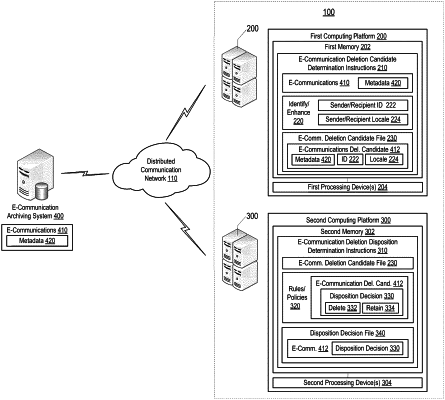| CPC G06F 21/6263 (2013.01) [G06F 21/31 (2013.01); G06Q 50/00 (2013.01); H04L 51/222 (2022.05); H04L 51/56 (2022.05); G06F 2221/2113 (2013.01); G06F 2221/2141 (2013.01)] | 17 Claims |

|
1. A system for defensible electronic communication (e-communication) disposition, the system comprising:
a first computing platform including a first memory and one or more processing devices in communication with the first memory, wherein the first memory stores e-communication deletion candidate determination instructions that are executable by the one or more processing devices and configured to:
receive, from an e-communication archiving system, metadata for each of a plurality of e-communications, wherein the metadata includes (i) an e-communication identifier, (ii) a sender of the e-communication, (iii) one or more recipients of the e-communication, and (iv) a date on which the e-communication was sent or posted,
identify, for each of the plurality of e-communications, (v) an identifier for at least one of the sender and the one or more recipients, and (vi) a geographic work location for the at least one of the sender and the one or more recipients, and
generate and initiate communication of a first e-communication deletion candidate file that lists at least a portion of the plurality e-communications as e-communication deletion candidates and includes, for each listed e-communication, (i)-(vi); and
a second computing platform including a second memory and one or more second processing devices, wherein the second memory stores e-communication deletion disposition determination instructions that are executable by the one or more second processing devices and configured to:
receive the e-communication deletion candidate file from the first computing platform,
apply a plurality of rules and policies to each of the e-communication deletion candidates in the e-communication deletion candidate file to determine, for each of the e-communication deletion candidates, based on (i)-(vi), a disposition decision, wherein the plurality of rules and policies include at least (a) legal hold status of the at least one of the sender and the one or more recipients, and (b) deletion requirements of the geographic work location of the at least one of the sender and the one or more recipients, wherein the disposition decision includes one of delete the e-communication from within e-communication archiving system or retain the e-communication within the e-communication archiving system, and
generate and initiate communication of a disposition decision file to the first computing platform, wherein the disposition decision file lists the electronic communications and includes a corresponding disposition decision,
wherein the first memory further stores e-communication deletion candidate throttling instructions that are executable by the one or more first processing devices and configured to:
determine current processing demands on the one or more second processing devices executing the e-communication destruction disposition determination instructions exceed a predetermined processing demand threshold based on a comparison between a first volume of e-communication destruction candidates communicated to second computing platform and a second volume of disposition decisions received at the first computing platform, and
in response to determining that the current processing demands exceed the predetermined processing demand threshold, delay initiating communication of subsequent e-communication deletion candidate files until processing demand is determined to be below the predetermined processing demand threshold.
|